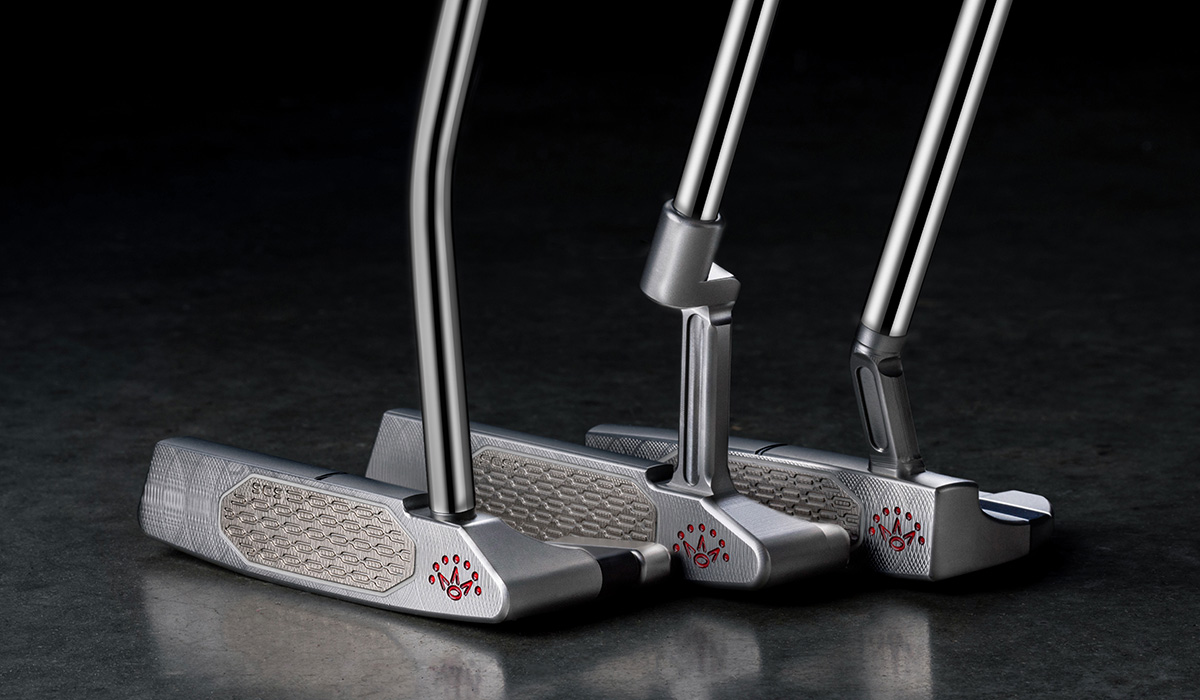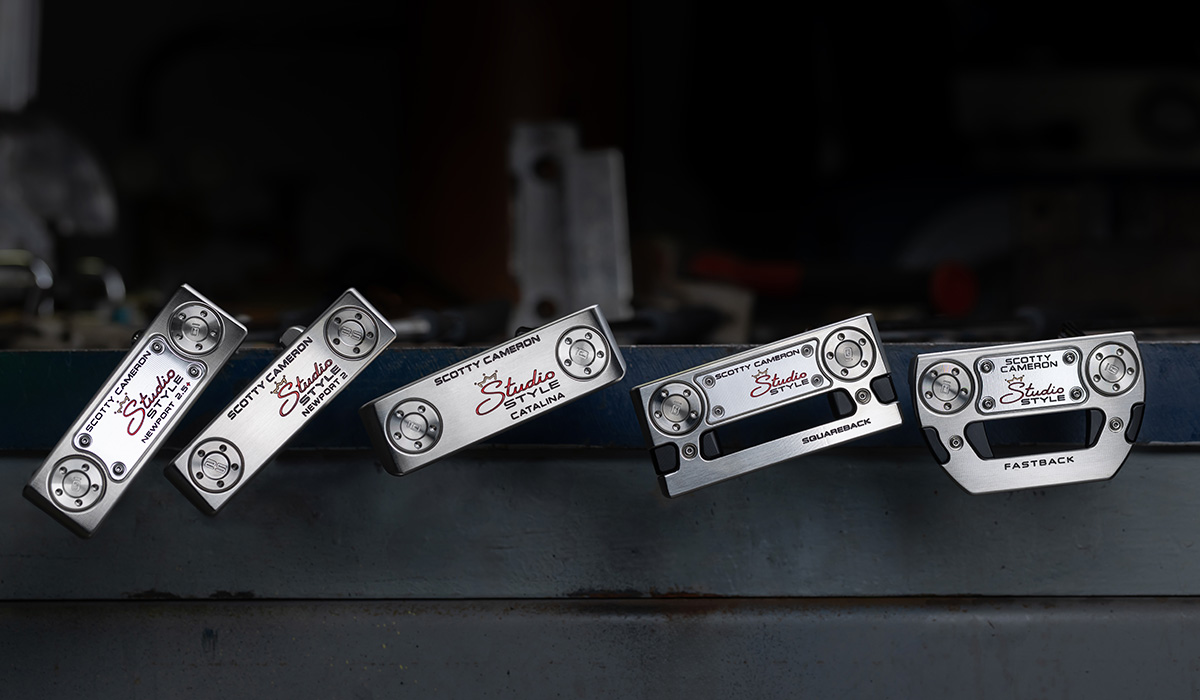Scotty Cameron putters are designed with a variety of neck, shaft and bend configurations not only to give players a wide range of options to select from, but also to create specific performance characteristics based on the type of neck paired with a specific putter shape.
Based on decades of research and development at the Scotty Cameron Putter Studio working with the game’s best players, we’ve outlined some ideas based on types of putter necks, shafts and bends to consider when selecting a putter.
Different neck and shaft configurations can guide your decision when choosing the best putter for your game. From the size and shape of the putter head to the lines and contours, to the all-important neck and shaft design, the way your putter sets up to you relies heavily on the type of neck, shaft and bend configuration you choose for your putter—for a blade or mallet.
Scotty Cameron putters are designed with a variety of neck, shaft and bend configurations not only to give players a wide range of options to select from, but also to create specific performance characteristics based on the type of neck paired with a specific putter shape.

Types of Necks
- Plumbing (Standard, Long Neck, Mid-Neck)
- Jet/small slant
- Round Neck
- Flow neck
Types of shafts / shaft bends
- Single mid-bend
- Single low-bend
- Double bend
- Straight shaft
Although a variety of aspects determine the selection of a putter, our putter design team and fitters begin by assessing the following four factors when helping a player select a putter with the appropriate neck and shaft design: face awareness, alignment preferences, hand height and posture.
TOE FLOW & FACE AWARENESS
A putter’s neck and shaft design directly correlates to face awareness. Toe flow, also referred to as toe hang, or described by its player benefit, face awareness, is the player’s ability to assess where the putter face is—and how it rotates—relative to the putter’s path through the putting stroke, which usually follows a slight arc. Also referred to as “toe flow,” the idea of face awareness is a gauge of “feel” and how a putter swings in the putting stroke.
Some players prefer more toe flow, or face awareness, with certain putter necks (e.g., jet, flow, round, plumbing, low-bend shafts) designed to promote varying degrees of toe flow and face rotation in the putting stroke. Others prefer less toe flow, or face awareness and choose necks and shafts that minimize rotation (e.g., mid-bend shaft, straight shaft, long neck). In choosing a putter, players should consider how much face awareness they prefer and then match the putter with the corresponding neck and shaft bend type to match their personal preference.
“What does the player feel when the putter swings? I ask this during every putter fitting. How did the putter path feel? Inside? Outside? Straight back? And then I can look on the cameras and see what their path was to see if it matches what the player feels. If a player says they can't identify feel or can't feel where the path is, I give them a putter with a jet neck and instantly the player tells me how they can feel the putter swing. They can feel where the face is. The face matches where the path is. If a player doesn’t want to feel an aggressive arc but wants to feel like the putter’s going more straight back, that's where putters with mid-bend shafts come into play.”—Paul Vizanko, Director Putter Fitting & Player Development
PUTTER ALIGNMENT PREFERENCES
Some players prefer more toe flow, or face awareness, with certain putter necks (e.g., jet, flow, round, plumbing, low-bend shafts) designed to promote varying degrees of toe flow and face rotation in the putting stroke. Others prefer less toe flow, or face awareness and choose necks and shafts that minimize rotation (e.g., mid-bend shaft, straight shaft, long neck). In choosing a putter, players should consider how much face awareness they prefer and then match the putter with the corresponding neck and shaft bend type to match their personal preference.
From sight dots, lines and arrows on the topline, to tracer lines in the flange, to the actual shape of the putter head, to the type of neck and shaft bend, each of these design components represents a way for the player to align the putter to the ball—as well as the player to the putter—at address, squaring the face to the intended target line. The end-goal is, of course, to make more putts, consistently.
So, how do different neck designs and shaft bends factor into overall alignment? Players who use the neck for body alignment tend to prefer putters with plumbing necks. Players who prefer to line up to the leading edge of the putter often prefer a mid-bend or jet neck as it gets the neck "out of the way," or out of view at address and gets their eye right to the leading edge.
“We offer a lot of different alignment options for a reason. We realized that what works for some players may not work for others. With mallets, players are looking for designs that have hard, crisp edges. Others like having more rounded features so that the putter blends into the ground. And we work with sight lines to give players directional alignment, which plays into the type of neck to choose, as well.” —Austie Rollinson, Senior Director Putter R&D
HAND HEIGHT
Different neck and shaft options promote different hand heights in a player's setup. Hand height refers to the vertical position of the hands on the shaft relative to the player’s body and the ground, essentially how high or low the hands are when holding the putter at address. Depending on what position a player prefers to get into their best setup, the neck design can support those positions. We also use hand height on the putter shaft during the fitting process to help determine the ideal length and style of putter that matches the player's posture, setup, and stroke mechanics.
Low hands (i.e., hands that hang down more vertically) call for a shorter putter, often around 33 inches, and suggest a putter design with more toe hang, or putters with necks that promote an arc-style stroke (i.e., jet and flow necks, low bend shafts). This is a common setup for players who bend more at the waist or prefer their eyes over the ball. Proper lie angle ensures the putter face sits flat for consistent roll.
Hand height affects how the putter sits on the ground, as players with high hands often raise the toe. High hands (i.e., arms extended more outward) suggest a longer putter, often 34–35+ inches and may indicate a preference for a face-balanced putter for a more straight-back, straight-through stroke. Players with higher hand height may prefer a putter with a plumbing neck or mid-bend shaft.
"Part of the fitting process is getting to understand the player’s path in relation to their putting stroke. And then I need to see where their hands need to be to easily recreate that path. Do the hands need to be low so they feel like the putter swings more? Or, are the hands high so they don't feel as much arc? Either way, they're going to have an arc. But if their hands are slightly lower, they feel like there's more arc. Sometimes we're looking at a shaft plane that goes down the arms through the shaft, and that's where I use different necks to set that height.”—Paul Vizanko, Director Putter Fitting & Player Development
POSTURE
When fitting a player at the Putter Studio, the team closely analyzes a player’s posture to optimize setup, aim, and stroke mechanics—as well as the current putter and setup the player is using. Posture changes how the golfer sees the line. A fitter might rotate putter heads, change alignment aids, or suggest different neck/shaft bends based on what “frames” the target best from the golfer’s eye position.
They observe whether the player is upright, hunched, or somewhere in between. This impacts how the putter needs to be designed or adjusted. The player is observed regarding how they naturally set up to the ball. This includes:
- Spine angle
- Eye position over the ball
- Hand position and hang
- Arm length and bend
- Distance from the ball
- Balance and weight distribution
After closely analyzing a player's posture to optimize setup, aim, and stroke mechanics, the Putter Studio team assesses spine angle, eye position, hand placement, and distance from the ball to determine ideal putter length, lie angle, loft, and grip. A more upright posture may require a longer putter, while a bent-over stance needs a shorter one. Lie angle is adjusted so the putter sits flat, and loft is fine-tuned based on shaft lean. Ultimately, they tailor the putter to match the golfer’s natural stance and visual preferences.

Choosing the right putter neck, shaft, and bend configuration is a highly personalized process that can significantly influence a player’s setup, feel, and stroke consistency. Extensive research at the Scotty Cameron Putter Studio highlights that these design elements are crucial in shaping face awareness, alignment, hand height, and posture—all key factors that affect putting performance.
Different neck types, such as plumbing, jet, or flow, combined with various shaft bends, create unique swing dynamics and visual cues tailored to individual preferences. Players who want more “toe flow” may choose necks that promote face rotation, while others prefer designs that minimize it for a straighter stroke.
Alignment aids integrated with specific neck designs help players consistently square the face to the target. Additionally, hand height and posture directly impact putter length and lie angle, ensuring the putter matches the player’s natural stance and stroke mechanics. Ultimately, selecting the ideal putter requires careful fitting and regard for the type of putter neck design that best suits the player’s unique style and performance goals.
Now that you’ve learned about how determining your optimal toe flow/face awareness, putter alignment preferences, hand height and posture can help you putt better, we suggest getting hands-on with the full Scotty Cameron lineup of Phantom and Studio Style putters. Try at least three different putters and neck/shaft options to get a feel for what fits your game the best. Check out Scotty Cameron putters at your local authorized Titleist golf shop or, for list of Scotty Cameron Showcase partners, check out our Showcase Partner locator.
